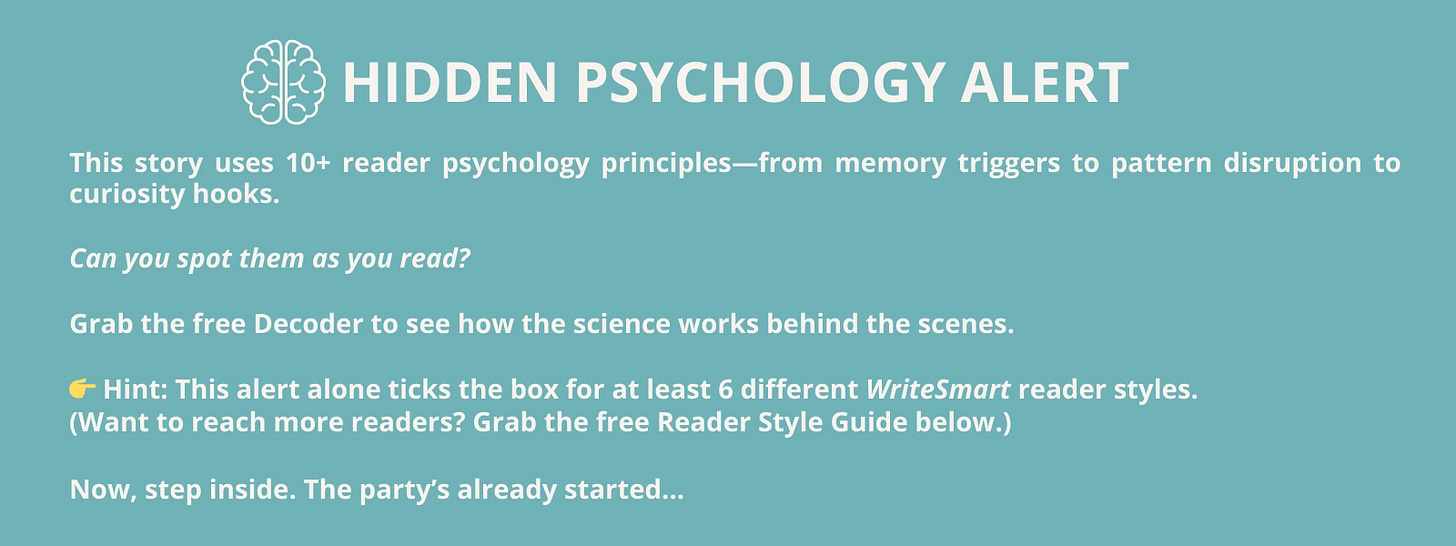Readers Are Guests. You’re the Host. Stop Making Your Party Suck.
Your readers are already halfway out the door. Here's how to stop them (with science).
It’s 8:15 PM, and you’ve just arrived late to the party.
It’s pouring. Rain slaps your shoulders, you’re dripping wet, and your mood is hovering between mildly annoyed and questioning all your life choices.
The front door is wide open, you step inside, soaked.
No greeting. No friendly host. No "Hey, let me take that wet coat!" So, you fling it over a random chair and hope for the best.
But you’re still optimistic—maybe this party will redeem itself. Maybe the buzz in the invite wasn’t all hype. Maybe there’s some magic inside that makes it worth the effort.
Then reality sets in.
Time to find sustenance. You beeline for the hors d’oeuvres, stomach growling.
Meat and cheese. That’s it.
You’re vegan. Fantastic.
Alright, Plan B: drink. You spot a tall guy handing out beverages.
"Hey, can I get a glass of wine?"
"Oh no, we’ve only got beer, sorry."
Beer. The liquid regret of a ninth-grade birthday party.
Hard pass.
And then—because the universe is hilarious—the country-western music gets a 10-decibel boost.
It’s weepy country-western. The kind that makes you want to cry in your beer.
This is not what you signed up for. You came here expecting a fun, engaging vibe, maybe some good connections, a little energy.
Instead? You’re stuck in a room full of strangers looking just as lost as you are—probably because the host is too busy taking selfies in the kitchen and posting about how 'epic' this party is instead of actually acknowledging your existence.
You take a breath. Look around.
No welcome. No food. No fun.
"What the hell am I doing here? This is a total waste of my time."
You came. You saw. You couldn’t wait to leave.
And that, dear writers, is exactly how readers feel when they land on an article that ignores them.
No clear structure? “Where am I?”
No relevance? “Why am I here?”
No engagement? “How fast can I leave?”
You see where this is going.
Readers show up, confused, looking for something worthwhile—only to be met with a mess that doesn’t consider them at all.
So they leave. And they don’t come back.
You’ve done this before—clicked on an article that promised value, only to find a dry, uninspiring repeat of 60 other articles.
And just like this party, you bailed.
So here’s the question to ask yourself before you hit publish:
Would I want to stay at this party?
As communication expert Nancy Duarte puts it,
“The greatest ideas are lost when they’re poorly delivered.”
That’s exactly what happens when readers bail before the real value lands. They’re not rejecting your ideas—they’re reacting to the entry point.
Translation for writers? You can have brilliant ideas—but if the reader never gets past your opening, they’ll never stick around long enough to care.
The Fix: How This Party Could Have Been Saved
A bad party (or a bad article) can be salvaged with just a little effort:
Welcome People In → A killer opening that pulls the reader in. Give them a reason to stay.
Make It Easy to Navigate → Structure matters. Subheads, bullet points, and short paragraphs help all reader types find what they need fast.
Offer a variety of snacks. → Know your audience. Not everyone wants the same thing—give them a mix of education, entertainment, and insight.
Mix Up the Music → Balance your tone and variety. Not everyone wants deep dives; not everyone loves surface-level takes. A good mix keeps them engaged.
Engage Like a Good Host → Your writing isn’t about you. It’s about your reader. Ask questions. Use relatable examples. Give them moments of recognition.
The best writing isn’t just about what you say; it’s about how you make readers feel.
People process information differently.
Some scan, some dive deep, some need story, some need structure.
Ignoring this means you’re only ever writing for one type of person—and the rest? They’re looking for another writer who actually gives a damn.
The Bottom Line: Are You Throwing a Party Worth Staying For?
You don’t have to cater to every tiny nuance, but you do need to care.
Think of it this way: some readers crave action, others want depth, some need a good story, and some just want the damn bullet points.
Hit one from each cluster, and you’ve already made their day.
Writers who do—build loyalty.
Writers who don’t—build exit strategies.
Your Move
You just read the article.
You saw how bad writing drives readers away—and how great writing makes them stay.
Want to know exactly why this piece worked?
✅ Grab the WriteSmart Decoder — a free bonus that reveals 10+ psychology principles behind the story you just read.
You’ll never look at writing the same way again.
PS: This approach is science-backed and built on proven psychology and reader engagement principles I’ve studied for years. (That doesn’t mean it can’t be fun!)





Cameron! This is such sound advice. Our writing really isn't about us. It's about our readers! I'll never forget my dad telling me this when I was writing a eulogy for my mom's memorial. "This isn't about you," he had told me. It was about honoring my mom's memory and giving the audience (our dear friends and family who sat in the service) something to hold onto to help them grieve. This sentiment has stayed with me and I love remembering the same holds true in the writing we put out into the world here on Substack. Thank you!
Love the analogy. Good post Cameron!